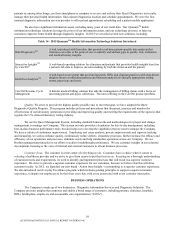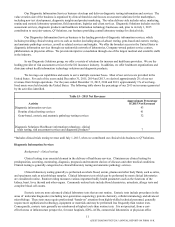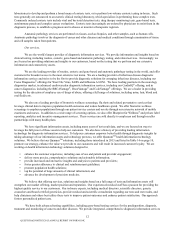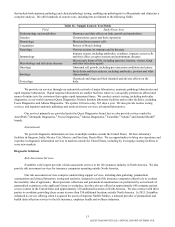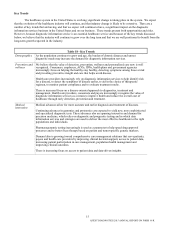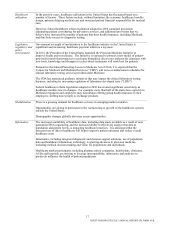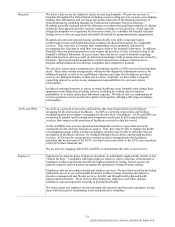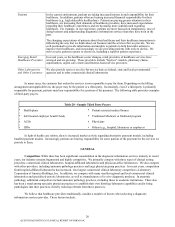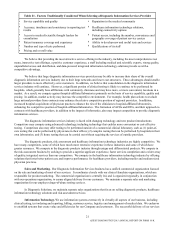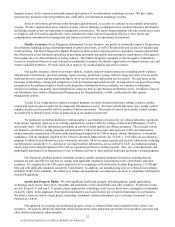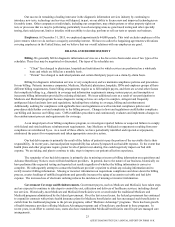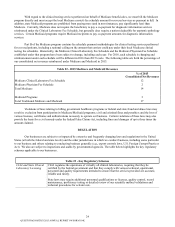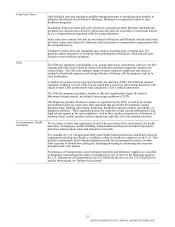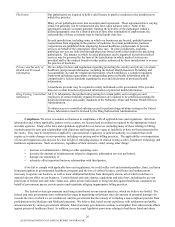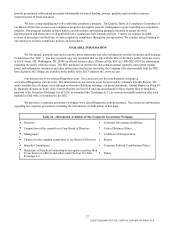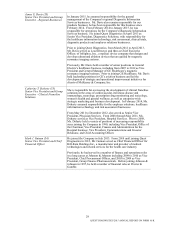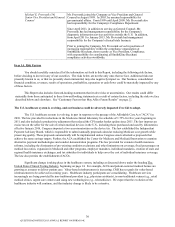Quest Diagnostics 2015 Annual Report Download - page 24
Download and view the complete annual report
Please find page 24 of the 2015 Quest Diagnostics annual report below. You can navigate through the pages in the report by either clicking on the pages listed below, or by using the keyword search tool below to find specific information within the annual report.
20
Patients In the current environment, patients are taking increased interest in and responsibility for their
healthcare. In addition, patients often are bearing increased financial responsibility for their
healthcare (e.g., high deductible health plans). Patients are paying greater attention to their
healthcare, are increasing their demands of healthcare providers, have increased expectations
regarding their healthcare experiences and are becoming more sophisticated regarding
healthcare. For example, in our experience, patients are more focused on transparency, ease of
doing business and understanding diagnostics information services than they have been in the
past.
The changing expectations of patients about their healthcare and their healthcare transactions is
influencing the way that we think about our business and the services that we provide. We are
well positioned to provide information and insights to patients to help them take actions to
improve their healthcare, and increasingly we are providing patients with tools to do this. We
strive to give patients reasons to choose us, including a superior patient experience.
Emerging Retail
Healthcare Providers In recent years, as the healthcare sector changes, retail providers of healthcare services have
emerged and are growing. These providers include "big-box" retailers, pharmacy chains,
supermarkets, urgent care centers and Internet-based service providers.
Other Laboratories
and Other Customers We also provide services on a fee-for-service basis to federal, state and local governmental
agencies and to other commercial clinical laboratories
In many cases, the customer that orders the services is not responsible to pay for them. Depending on the billing
arrangement and applicable law, the payer may be the patient or a third party. Increasingly, even if a third party is primarily
responsible for payment, patients may bear responsibility for a portion of the payment. The following table provides examples
of third-party payers.
Table 20 - Sample Third Party Payers
Health plans Patient-centered medical homes
Self-insured employer benefit funds Traditional Medicare or Medicaid program
ACOs Physicians
IDNs Others (e.g., hospital, laboratory or employer)
In light of health care reform, there is increased market activity regarding alternative payment models, including
bundled payment models. Increasingly, patients are bearing responsibility for some portion of the payment for the services we
provide to them.
GENERAL
Competition. While there has been significant consolidation in the diagnostic information services industry in recent
years, our industry remains fragmented and highly competitive. We primarily compete with three types of clinical testing
providers: commercial clinical laboratories, hospital-affiliated laboratories and physician-office laboratories. We also compete
with other providers, including anatomic pathology practices and large physician group practices. In recent years, competition
from hospital-affiliated laboratories has increased. Our largest commercial clinical laboratory competitor is Laboratory
Corporation of America Holdings, Inc. In addition, we compete with many smaller regional and local commercial clinical
laboratories and specialized esoteric laboratories, as well as manufacturers of in vitro diagnostic products. In anatomic
pathology, additional competitors include anatomic pathology practices, including those in academic institutions. There also
has been a trend among specialty physician practices to establish their own histology laboratory capabilities and/or bring
pathologists into their practices, thereby reducing referrals from these practices.
We believe that healthcare providers traditionally consider a number of factors when selecting a diagnostic
information services provider. Those factors include:
QUEST DIAGNOSTICS 2015 ANNUAL REPORT ON FORM 10-K


